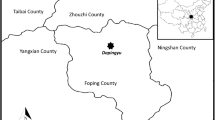Abstract
Arboreal and semi-arboreal mammals have remarkably diverse positional behavior and associated morpho-functional adaptations related to the three-dimensional nature of their arboreal habitat. In this context, we investigated the positional behavior of captive Siberian chipmunks (Tamias sibiricus), small bodied semi-arboreal sciurids, in an aviary-type wire-mesh cage containing both terrestrial and arboreal supports. We sampled four adult individuals during a five-month period using focal animal sampling every 30 s. Results showed that animals preferred 8–10 cm horizontal supports and always avoided vertical supports. Locomotion occurred on both terrestrial and 8–10 cm arboreal supports whereas postural behavior occurred primarily on 8–10 cm arboreal supports. Quadrupedal walk dominated during locomotion, and occurred primarily on terrestrial horizontal supports, as is observed for other squirrels. The predominance of quadrupedal locomotion is consistent with the postcranial morphology of chipmunks. In contrast, clawed locomotion occurred on wire mesh and on >13 cm arboreal vertical supports. Finally, pronograde and orthograde sitting, both on 8–10 cm arboreal supports and on terrestrial supports, were the predominant postures, implying general predisposition to selection of stable postures on stable supports for food item manipulation and ingestion.





Similar content being viewed by others
References
Biewener AA (1983) Locomotory stresses in the limb bones of two small mammals: the ground squirrel and chipmunk. J Exp Biol 103:131–145
Blake BH, Gillett KE (1984) Reproduction of Asian chipmunks in captivity. Zoo Biol 3:47–53
Bock WJ, Winkler H (1978) Mechanical analysis of the external forces on climbing mammals. Zoomorphologie 91:49–61
Bryant MD (1945) Phylogeny of nearctic Sciuridae. Am Midl Nat 33:257–390
Cant JGH (1992) Positional behavior and body size of arboreal primates: a theoretical framework for field studies and an illustration of its application. Am J Phys Anthrop 88:273–283
Cant JGH, Youlatos D, Rose MD (2001) Locomotor behavior of Lagothrix lagothricha and Ateles belzebuth in Yasuni National Park, Ecuador: general patterns and nonsuspensory modes. J Hum Evol 41:141–166
Cartmill M (1972) Arboreal adaptations and the origin of the order Primates. In: Tuttle R (ed) The functional and evolutionary biology of the Primates. Aldine–Atherton, Chicago, pp 97–122
Cartmill M (1974) Pads and claws in arboreal locomotion. In: Jenkins FA (ed) Primate locomotion. Academic, New York, pp 45–83
Cartmill M (1992) New views on primate origins. Evol Anthropol 3:105–111
Crompton RH (1995) Visual predation, habitat structure, and the ancestral primate niche. In: Alterman L, Doyle GA, Izard MK (eds) Creatures of the dark: the nocturnal prosimians. Plenum Press, New York, pp 11–30
Dagosto M (1994) Testing positional behavior of Malagasy lemurs: a randomization approach. Am J Phys Anthrop 94:189–202
Doran DM (1992) Comparison of instantaneous and locomotor bout sampling methods: a case study of adult male chimpanzee locomotor behavior and substrate use. Am J Phys Anthrop 89:85–99
Emry RJ, Thorington RW Jr (1982) Descriptive and comparative osteology of the oldest fossil squirrel, Protosciurus (Rodentia: Scuiridae). Smiths Contrib Paleobiol 47:1–35
Emry RJ, Thorington RW Jr (1984) The tree squirrel Sciurus (Scuiridae, Rodentia) as a living fossil. In: Eldredge N, Stanley SM (eds) Living fossils. Springer, Berlin Heidelberg New York, pp 23–31
Essner RL (2002) Three-dimensional launch kinematics in leaping, parachuting, and gliding squirrels. J Exp Biol 205:2469–2477
Garber PA, Sussman RW (1984) Ecological distinctions between sympatric species of Saguinus and Sciurus. Am J Phys Anthrop 65:135–146
Garland T Jr, Losos JB (1994) Ecological morphology of locomotor performance in squamate reptiles. In: Wainwright PC, Reilly SM (eds) Ecological morphology. Chicago University Press, Chicago, pp 240–302
Hildebrand M (1994) Analysis of vertebrate structure. Wiley, New York
Jacobs J (1974) Quantitative measurement of food selection. Oecologia 14:413–417
Kawamichi T (1989) Nest structure dynamics and seasonal use of nests by Siberian chipmunks (Eutamias sibiricus). J Mammal 70:44–57
Lauder GV (1998) On the inference of function from structure. In: Thomason JJ (ed) Functional morphology in vertebrate paleontology. Cambridge University Press, Cambridge, pp 1–18
Martin P, Bateson P (1994) Measuring behaviour. Cambridge University Press, Cambridge
Martin RD (1990) Primate origins and evolution: a phylogenetic reconstruction. Chapman and Hall, London
Prost JH (1965) A definitional system for the classification of primate locomotion. Am Anthropol 67:1198–1214
Rasmussen DT (1990) Primate origins: lessons from a neotropical marsupial. Am J Primatol 22:263–277
Soligo C, Martin RD (2006) Adaptive origins of primates revisited. J Hum Evol 50:414–430
Stafford BJ, Thorington RW Jr, Kawamichi T (2003) Positional behavior of Japanese giant flying squirrels (Petaurista leucogenys). J Mammal 84:263–271
Stalheim-Smith A (1984) Comparative study of the forelimbs of the semi-fossorial prairie dog, Cynomys gunnisoni, and the semi-arboreal fox squirrel, Sciurus niger. J Morphol 180:55–68
Sussman RW (1991) Primate origins and the evolution of angiosperms. Am J Primatol 23:209–223
Swiderski DL (1993) Morphological evolution of the scapula in tree squirrels, chipmunks, and ground squirrels (Sciuridae): an analysis using thin-plate splines. Evolution 47:1854–1873
Szalay FS, Bock WJ (1991) Evolutionary theory and systematics: relationship between process and patterns. Z Zool Syst Evol 29:1–40
Thorington RW Jr, Darrow K, Betts ADK (1997) Comparative myology of the forelimb of squirrels (Sciuridae). J Morphol 234:155–182
Thorington RW Jr, Thorington EM. (1989) Postcranial proportions of Microsciurus and Sciurillus, the American pygmy tree squirrels. Adv Neotrop Mammal 1989:125–136
Youlatos D (1999) Locomotor and postural behavior of Sciurus igniventris and Microsciurus flaviventer (Rodentia, Sciuridae) in eastern Ecuador. Mammalia 63:405–416
Acknowledgments
We are particularly indebted to Mr C. Apostolidis, Director of Green Spaces of the Municipality of Thessaloniki, for granting permission to work in the Municipal Zoological Garden. This project would not have been achieved without the constant support and help of Mr M. Petrakakis and Mrs A. Papageorgiou, Directors of the Zoological Garden, and the Garden staff. Financial support was provided by the Aristotle University of Thessaloniki. Finally, this report was greatly improved by the insightful remarks of two anonymous reviewers.
Author information
Authors and Affiliations
Corresponding author
About this article
Cite this article
Youlatos, D., Michael, D.E. & Tokalaki, K. Positional behavior of Siberian chipmunks (Tamias sibiricus) in captivity. J Ethol 26, 51–60 (2008). https://doi.org/10.1007/s10164-006-0029-5
Received:
Accepted:
Published:
Issue Date:
DOI: https://doi.org/10.1007/s10164-006-0029-5




